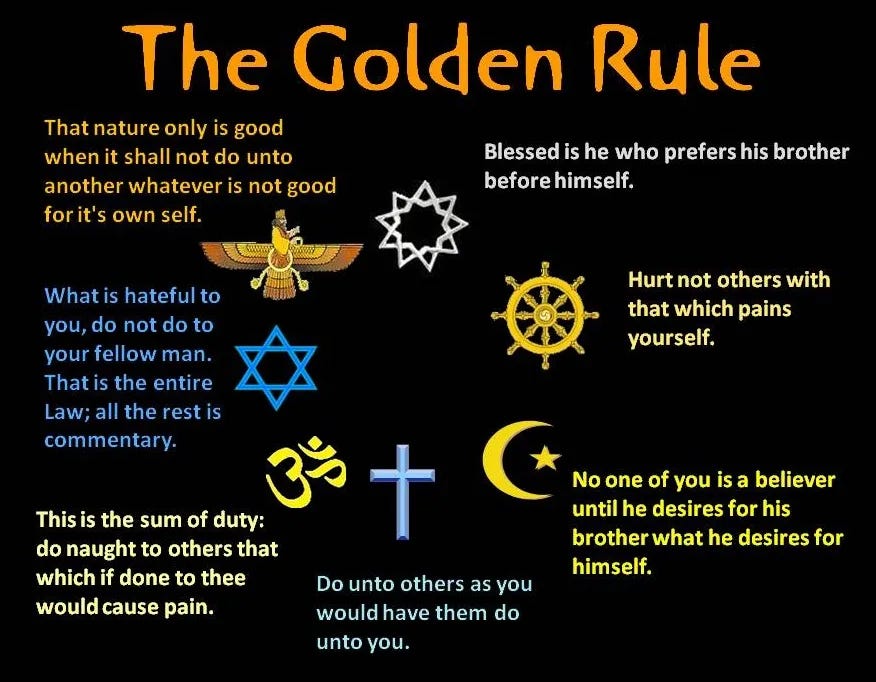The Golden Rule and the Power of Shared Intention
How New Thought Deepens One of Humanity’s Oldest Ethical Principles
“New Thought teaches that kindness and intention are not just virtues, they are creative forces.”
The Golden Rule, “Do unto others as you would have them do unto you,” is among the most enduring ethical principles in human history. It cuts across cultures, religions, and time periods, offering a universal guide for cultivating empathy and mutual respect.
While the idea is widely known, its deeper implications, especially when viewed through the lens of New Thought philosophy, deserve renewed attention. At its heart, the Golden Rule, along with its natural extension, “What I want for me, I desire for thee,” points to a vision of universal love and shared well-being. By exploring both the principle and its spiritual roots, we can better understand their transformative potential in daily life.
The Deeper Meaning of the Golden Rule
The Golden Rule is both simple and profound. It calls on us to treat others with the same care and compassion we wish for ourselves. Nearly every major tradition includes a version of this idea. Christianity teaches, “Do to others as you would have them do to you” (Luke 6:31). Buddhism reminds us, “Treat not others in ways that you yourself would find hurtful.” Indigenous teachings often emphasize interconnectedness, which reflects the same ethic of reciprocity.
In New Thought, the Golden Rule takes on added depth. It reflects the principle of Oneness, the idea that all life is connected. How we treat others shapes not only our external relationships but our internal world as well. Acting with kindness aligns us with spiritual laws of harmony and abundance, setting the stage for a more peaceful and prosperous life for all.
What I Want for Me, I Desire for Thee
The phrase “What I want for me, I desire for thee” builds on the Golden Rule. While the Golden Rule focuses on behavior, this concept centers on intention. It encourages us to hold a sincere wish for the happiness, health, and success of others. It is a quiet recognition that the good we wish for ourselves is not diminished when shared, it is multiplied.
This idea is deeply rooted in New Thought philosophy. When we desire good for others without envy or comparison, we tap into a mindset of abundance. Rather than seeing others’ success as a threat, we begin to see it as evidence of what is possible for all. Our intentions then become a creative force, helping to draw good into our own lives as well.
New Thought’s Role in Reviving These Principles
Emerging in the 19th century, New Thought emphasizes the power of thought, intention, and spiritual awareness in shaping reality. Its core teachings hold that our thoughts influence not only our personal experiences but the collective atmosphere in which we live.
Within this framework, the Golden Rule and its counterpart are not just moral guidelines. They are tools for spiritual practice. Acting with empathy and wishing others well become ways to raise our vibration and help uplift the world. These choices are not just kind, they are powerful. They align us with the universal energy of love and allow us to become conscious participants in the creation of a better reality.
How to Apply These Principles in Real Life
Living by these principles can transform our personal and public lives. In close relationships, the Golden Rule reminds us to bring empathy into disagreements. When a friend or partner falls short, meeting them with compassion instead of blame deepens trust and connection.
In the workplace, respect and fairness lead to stronger teams and more humane leadership. A manager who listens, supports, and shares credit creates an environment where people thrive. Similarly, “What I want for me, I desire for thee” reminds us that we lose nothing by celebrating others’ success. In fact, we gain community and a shared sense of growth.
On a larger scale, these ideas can influence public policy. A government guided by the Golden Rule would prioritize equitable access to healthcare, education, and justice. Communities would care for their most vulnerable not out of charity, but from a belief in mutual responsibility and shared humanity.
New Thought adds practical tools to help live these values. Affirmations such as “I desire peace, joy, and abundance for all” help rewire our thinking. Visualization allows us to imagine the world we want and act in ways that support its unfolding. Mindfulness helps us pause and respond with intention rather than impulse.
The Challenge of Living These Values
These ideas are easy to understand but not always easy to practice. One common mistake is to treat them as transactional, being kind only to receive kindness in return. But the true power of these principles lies in unconditional goodwill.
Cultural differences can also pose challenges. What seems fair or respectful to one person might not feel the same to another. Here again, New Thought offers guidance. It encourages us to move beyond assumptions and center our actions on genuine care, curiosity, and shared understanding.
At times, the world may seem too harsh or divided for simple principles to make a difference. But that is exactly when they matter most. Practicing the Golden Rule in the face of anger, fear, or injustice becomes a radical act of faith in our shared potential.
Why This Matters Now
We live in an era marked by deep divisions. Political polarization, economic inequality, and social isolation are common features of modern life. In this context, the Golden Rule and its New Thought expressions offer a path forward.
They remind us that healing begins with intention. A single person choosing empathy over blame or care over cruelty creates ripples that extend outward. When more people make that choice, change begins to accelerate.
Great leaders such as Mahatma Gandhi and Martin Luther King Jr. understood this. Their work was grounded in ethical and spiritual principles that challenged hatred with love and replaced fear with hope. They showed that the Golden Rule is not passive. It is a call to courageous action rooted in moral clarity.
Conclusion
The Golden Rule and “What I want for me, I desire for thee” are more than old sayings. They are spiritual tools for modern life. Rooted in both ancient wisdom and New Thought insight, they show us how to live in alignment with love, abundance, and connection.
By practicing these principles, we help create a world that reflects our highest values. We become builders of peace, kindness, and shared prosperity. What we want for ourselves, we can wish for others. And in doing so, we find that a better world is not just possible, it is already beginning.






Beautiful!
A truly beautiful way to live. One idea I’d like to add is to include non-human animals to this kindness. It is easier to think of this concept between humans, but takes it to an even higher level when non-humans are included. ❤️🐾❤️